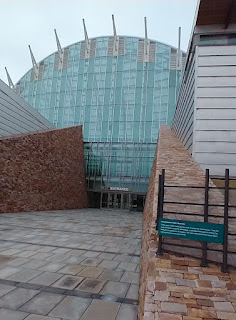Moominmama's Adventures: On the Road Again
In which Moominmama returns to the road in 2023, running away from winter, but not without winter giving chase...
Travel fever propelled Moominmama from home after the first week in February, with the goal of spending spring in the deserts of Arizona. With park reservations made six months in advance, there was pressure to hit the road regardless of what was blowing in New Hampshire. And blowing it was, with the temperature exactly 1° on departure, with a frighening wind chill.
I reclaimed the Moominhouse in Tennessee, returning to a camping spot near Chattanooga to drain the pipes of antifreeze, rinse the water tank and make the trailer inhabitable again. Clusters of daffodils and shirtsleeve weather made it seem like winter was far away.
After a day to clean and restock, Moominmama headed west, aiming for Oklahoma City to visit the youngest Moomin and stay at Lake Thunderbird State Park in Norman. It was in Oklahoma City where I stopped at the First Americans Museum, which opened in 2021.
The museum represents a success story that started with cleaning a contaminated riverside site before recreating a Mississipian-culture style earthen mound oriented to the sun and stars. The museum, integrated into that mound is dedicated to the history and experience of First Americans, a joint project involving the 39 tribes in Oklahoma, many of whom, like the Cherokee, were driven here against their will.
That turns out to include a group of Seneca-Cayuga people, who left Western New York (and the Rochester area) for Ohio prior to the Revolutionary War, already frustrated by the European incursion. Ultimately, they ended up in Oklahoma in the 1830s as tribes everywhere were pushed west.
Others came to Oklahoma from the opposite side of the country. A band of Modoc from northern California and southern Oregon were taken prisoner and exiled to Oklahoma in 1873 for fighting soldiers ordered to keep them on a Modoc reservation. Oklahoma at the time must have looked like a vast empty space to solve the "Indian problem." At least until oil was discovered!
From Oklahoma, I headed into Texas. Already the threat of winter was approaching, and I picked a stay in Caprock Canyon over a planned visit to Palo Duro Canyon because Caprock's overnight temperature was forecast to be about 5 degrees warmer.
Even though the temperature would be below freezing for several hours, I knew heat inside the trailer could help protect the piping.
I also set aside a day to hike the canyon and was fascinated by the layers of white gypsum crystals that are layered in the red rock, creating bubbles like this one that someone broke through on the path!
But after a lovely day spent in and along the top of the canyon, the wind came in hard. I felt like I was trying to sleep in a subway car rattling down the tracks! The temperature dropped more than forecast (to 18°F), and the wind made it impossible to retain heat near the water tank and pipes.
By morning, something between the tank and the water pump had frozen, and I had to hope I hadn't done any permanent damage.
My next stop was Roswell, NM, and while it was going to be well into the 40°s during the day, it would again dip well below freezing at night. A quick visit to Walmart, and I had more RV antifreeze. I drained the pipes of water again and refilled the antifreeze. For the next two nights, I'd rely on bathrooms en route and a bucket at night.
From Roswell, I headed up to the Continental Divide, crossing this time at just under 8,000 feet. The high plateau had snow, but it's a beautiful and remote country. That's where the top photo was take. The blond grasses stretch for miles in and around black volcanic rock and through an area that had once been an ancient sea.
Coming out of Socorro, NM, I kept seeing signs for VLA and assumed it was some kind of veterans office, but the signs continued to appear well outside town. Turns out I was passing the "Very Large Array," a huge radio astronomy center spread out for miles on the remote Plains of San Agustin.
The array of 27 dishes, each measuring 82 feet in diameter, creates what's called a radio telescope, which is used to map gas and molecular clouds and pinpoint ejections of plasma from black holes. More impressive than any spooky alien stories from Roswell as far as I'm concerned!
I spent one more night in the high country after crossing into Arizona. Snow crunched under my feet at the campground, and I could have gone skiing if so inclined. But I was eager to get to lower elevations, put water back into the Moominhouse and make sure I didn't have any leaks!
Pulling into Lake Pleasant Regional Park north of Phoenix was a blessing. While the wind would take another run at the Moominhouse a few nights into our stay, temperatures remained above freezing. Draining the antifreeze, refilling the water and running the water pump suggested I'd made it through this adventure without damage -- a huge relief.
And the countryside has been glorious! One of the park rangers said this has been a wet winter and that has prompted many of the flowers to come out early. Spring is not fully underway, but that leaves even more to look forward to.
These are brittle bushes in front of the saguaro that bloom in spring and will go dormant in the heat, turning into brittle stalks.
I've settled in after many days of driving, broken out the hiking shoes and gone exploring. I'm learning about desert flowers and cacti. More in my next post about that! Below a view of the lake!











What an adventure! So glad the cold temperatures didn’t damage anything! Hopefully you will see lots of flowers and enjoy the beauty of the Southwest!
ReplyDelete